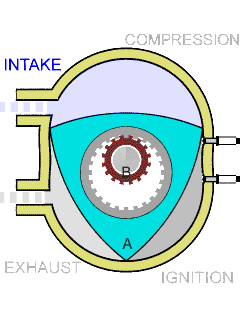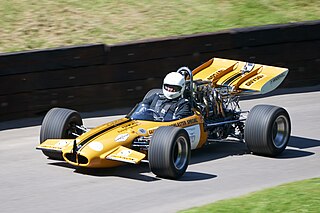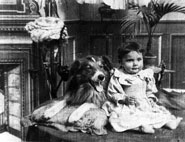Related Research Articles

The Wankel engine is a type of internal combustion engine using an eccentric rotary design to convert pressure into rotating motion. The concept was proven by German engineer Felix Wankel, followed by a commercially feasible engine designed by German engineer Hanns-Dieter Paschke. The Wankel engine's rotor, which creates the turning motion, is similar in shape to a Reuleaux triangle, with the sides having less curvature. The rotor spins inside a figure-eight-like epitrochoidal housing around a fixed-toothed gearing. The midpoint of the rotor moves in a circle around the output shaft, rotating the shaft via a cam.

The Ford Mustang is a series of American automobiles manufactured by Ford. In continuous production since 1964, the Mustang is currently the longest-produced Ford car nameplate. Currently in its seventh generation, it is the fifth-best selling Ford car nameplate. The namesake of the "pony car" automobile segment, the Mustang was developed as a highly styled line of sporty coupes and convertibles derived from existing model lines, initially distinguished by "long hood, short deck" proportions.

A supercar, also known as an exotic car, is a type of automobile generally described at its most basic as a street-legal sports car with race track-like power, speed, and handling, plus a certain subjective cachet linked to pedigree, exclusivity, or both. The term 'supercar' is frequently used for the extreme fringe of powerful, low-bodied mid-engineed luxury sportscars. A low car has both a low, handling-favorable center of gravity, and less frontal area than a front engined car, reducing its aerodynamic drag and enabling a higher top speed. Since the 2000s, the term hypercar has come into use for the highest performance supercars.
The year 1900 in film involved some significant events.
The following is an overview of the events of 1899 in film, including a list of films released and notable births.

The Chevrolet Corvette is a line of American two-door, two-seater sports cars manufactured and marketed by General Motors under the Chevrolet marque since 1953.

A muscle car is an American-made two-door sports coupe with a powerful engine, generally designed for high-performance driving.

William Crapo Durant was a leading pioneer of the United States automobile industry, founder of General Motors and co-founder of Chevrolet. He created a system in which a company held multiple marques – each seemingly independent, with different automobile lines – bound under a unified corporate holding company. Durant founded General Motors and co-founded Chevrolet with Louis Chevrolet. He also founded Frigidaire.

A brushless DC electric motor (BLDC), also known as an electronically commutated motor, is a synchronous motor using a direct current (DC) electric power supply. It uses an electronic controller to switch DC currents to the motor windings producing magnetic fields that effectively rotate in space and which the permanent magnet rotor follows. The controller adjusts the phase and amplitude of the current pulses that control the speed and torque of the motor. It is an improvement on the mechanical commutator (brushes) used in many conventional electric motors.

Cecil Milton Hepworth was a British film director, producer and screenwriter. He was among the founders of the British film industry and continued making films into the 1920s at his Hepworth Studios. In 1923 his company Hepworth Picture Plays went into receivership.

The Nash Rambler is a North American automobile that was produced by the Nash Motors division of Nash-Kelvinator Corporation from 1950 until 1954 in sedan, wagon, and fixed-profile convertible body styles.
Edmund E. Anderson was an automotive designer in the North American automotive industry at General Motors and notably as the lead designer for American Motors Corporation (AMC) from 1950 to 1961.
Walton Studios, previously named Hepworth Studios and Nettlefold Studios, was a film production studio in Walton-on-Thames in Surrey, England. Hepworth was a pioneering studio in the early 20th century and released the first film adaptation of Alice's Adventures in Wonderland.

David Hepworth was a British racing driver, who won the British Hill Climb Championship twice, in 1969 and 1971. In the early-mid 1960s Hepworth drove an Austin-Healey 3000 fitted with a Chevrolet engine in both rallies and circuit racing, but by 1968 he was driving a Hepworth-Oldsmobile; in this he won a Formula Libre race at Croft late in that season.

Coke bottle styling is an automotive body design with a narrow center surrounded by flaring fenders. This design element bears a general resemblance to a Coca-Cola classic glass contour bottle design. Industrial designer Raymond Loewy introduced it on the radical 1962 Studebaker Avanti gran turismo.

Rescued by Rover is a 1905 British short silent drama film, directed by Lewin Fitzhamon, about a dog who leads its master to his kidnapped baby, which was the first to feature the Hepworth's family dog Blair in a starring role; following the release, the dog became a household name and he is considered to be the first dog film star. The film, which according to Michael Brooke of BFI Screenonline, "marks a key stage in the medium's development from an amusing novelty to the seventh art," and, "possibly the only point in film history when British cinema unquestionably led the world," was an advance in filming techniques, editing, production and story telling.

Explosion of a Motor Car is a 1900 British silent comic trick film, directed by Cecil M. Hepworth, featuring an exploding automobile scattering the body parts of its driver and passenger. "One of the most memorable of early British trick films" according to Michael Brooke of BFI Screenonline, "was one of the first films to play with the laws of physics for comic effect." It features one of the earliest known uses in a British film of the stop trick technique discovered by French filmmaker Georges Méliès in 1896, and also includes one of the earliest film uses of comedy delay – later to be widely used as a convention in animated films – where objects take much longer to fall to the ground than they would do in reality. It is included in the BFI DVD Early Cinema: Primitives and Pioneers and a clip is featured in Paul Merton's interactive guide to early British silent comedy How They Laughed on the BFI website.
How It Feels to Be Run Over is a one-minute British silent trick film, made in 1900, and directed by Cecil M. Hepworth. As in other instances of the very earliest films, the film presents the audience with the images of a shocking experience, without further narrative exposition.
In legal terminology, the assured clear distance ahead (ACDA) is the distance ahead of any terrestrial locomotive device such as a land vehicle, typically an automobile, or watercraft, within which they should be able to bring the device to a halt. It is one of the most fundamental principles governing ordinary care and the duty of care for all methods of conveyance, and is frequently used to determine if a driver is in proper control and is a nearly universally implicit consideration in vehicular accident liability. The rule is a precautionary trivial burden required to avert the great probable gravity of precious life loss and momentous damage. Satisfying the ACDA rule is necessary but not sufficient to comply with the more generalized basic speed law, and accordingly, it may be used as both a layman's criterion and judicial test for courts to use in determining if a particular speed is negligent, but not to prove it is safe. As a spatial standard of care, it also serves as required explicit and fair notice of prohibited conduct so unsafe speed laws are not void for vagueness. The concept has transcended into accident reconstruction and engineering.

Percy Stow was a British director of short films. He was also the co-founder of Clarendon Film Company. He was born in Islington, London, England. He was previously associated with Cecil Hepworth from 1901 to 1903, where he specialized in trick films.
References
- ↑ Kitchin, Rob; Kneale, James (23 December 2005). Lost in Space: Geographies of Science Fiction. A&C Black. p. 153. ISBN 978-0-8264-7920-4.
- ↑ Beckman, Karen (13 July 2010). Crash: Cinema and the Politics of Speed and Stasis. Duke University Press. p. 42. ISBN 978-0-8223-9276-7.
- ↑ The American Film Institute Catalog of Motion Pictures: Film Beginnings. R. R. Bowker. 1995. p. 123. ISBN 978-0-8108-3021-9.